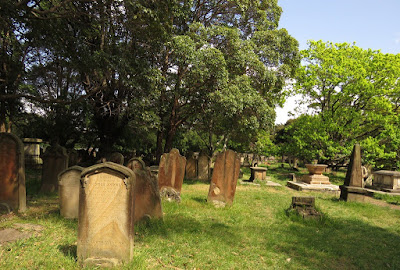Trees of death
This post was written before the terrorist attacks in Paris and elsewhere, but it resonates a little with those acts of violence. Trees are a source of solace and stability in a sometimes hostile world, and I often wonder why there aren't more in our cemeteries. I also wonder why our cemeteries aren't more attractive places to visit.
A few months ago I was waiting in a cemetery in Newtown, in the heart of the inner west of Sydney, for Georgina Reid to arrive so we could talk about why she likes the Camperdown Memorial Rest Park (aka Cemetery).
Within minutes I was swooped by magpies and saw two Goths take in the funereal air. Later a mother gently dropped her daughter over a fence onto a grave stone. Locals walked past with their dogs, and a crew of gardeners (or were they weeders) bobbed around with their heads down and bums in the air. I didn't expect so much life in a cemetery.
Then again, this is an unusual burial ground. It was started in 1858 and closed 18 years later, overflowing with bodies and not the most pleasant of places to visit. The upside of all that was plenty of nutrients for the newly planted trees that are still with us.
This cemetery has stately oaks, Canary Island Date Palms and one giant Moreton Bay Fig. It also has patches of remnant Kangaroo Grass, among which the weeders I saw were presumably do all they could to encourage various local wildflowers.
Horticulture is now part of a progressive cemetery. Not all mind you. Georgina mentioned some new cemeteries that call themselves Memorial Parks but are anything but a park - they are devoid of any vegetation other than turf and a rose or two (plastic or real).
In Melbourne, the Greater Metropolitan Cemeteries Trust looks after 17 cemeteries and they have very publicly stated their intent to create places that people visit more often, to picnic or enjoy in a cafe. For the Trust, horticulture is as important as tombstones. Kew Cemetery (aka Boroondara General Cemetery), near me in Melbourne, is extremely proud of its trees and you can do a walk to locate them all, plus the interesting graves...
There are plenty of more adventurous projects or project ideas out there about how to more efficiently deal with our bodies once we die, and how to make that connection stronger between humans and the rest of the living world.
The Daily Mail reported earlier this year on the US Urban Death Project, where corpses would be placed in a 'giant tower' to decompose for about six weeks, after which they would have converted, more or less, to compost which would be either returned to families or 'spread in national parks'. I'm not sure that national parks need to spread compost but we get the general idea.
The Mail quotes research from the USA showing that it takes 90 thousand tons of steel, 9 million metres of hardwood and 1.6 million tons of concrete to bury the dead in that country alone. Cremation has come under fire for the amount of energy used to combust a body.
One of the advertising slogans for the Urban Death Project, which is crowd sourcing for funds, is 'eventually I'll be a lemon tree' (here the Australian male, in particular, notoriously contributes some of themselves to a lemon tree when the relieve themselves in the backyard). The Project argues that is is more than simply a method for turning our no longer needed bodies into plant food, but a better way to understand our place in the natural world.
In Australia, Living Legacy, led by Warren Roberts, is a fledgling program to combine the ashes of the dead with living forests. This particular concept is likely to be more about a spiritual and intellectual connection with the living world than fertilising it, but it too is part of a change in our attitude towards the dead.
Trees in a cemetery, and trees that interfere (in the nicest way) with the plots, would seem to be a simple way to connect spent bodies with a world that continues beyond their life. We living can then enjoy those trees, and our cemeteries.
Note: All images are from Camperdown Cemetery and my chat with Georgina will become part of the second series of Talking Plants 'the radio show', to run on RN over summer.






Comments
Cheering to hear about the kangaroo grass remnants being preserved in even urban cemeteries. I know that whenever I was looking for rare species of orchid or small herbs in agricultured Aus, it was often a good bet to head to the cemetery of any small town. My father (a lepidopterist) does the same for rare butterfly or moth species which often remain only on small patches of native grass preserved in graveyards where, since towns were first established, stock were reliably kept out, and with any luck the caretakers had never been too diligent with the lawn mower :)